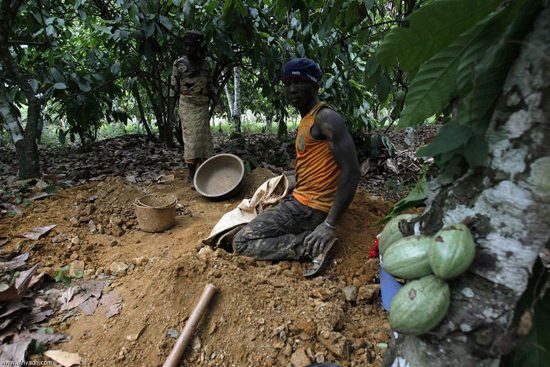1 in every 10 cocoa farmers approached by galamseyers to sell their lands for illegal mining
Sources within COCOBOD further reveal that strong seasonal winds and inadequate rainfall have exacerbated the situation, with current output forecasts hovering around the 500,000-ton mark for the season.
Over 14% of cocoa farmers, equivalent to 1 in 10, report being approached by individuals linked to illegal mining known as galamsey to purchase their farms for mining activities, according to the new report by IMANI Ghana.
This disturbing revelation while lacking a direct baseline for trend analysis IMANI Ghana asserts, aligns with growing anecdotal evidence suggesting an increasing willingness among cocoa farmers to sell their lands to illegal miners, or in some cases, engage in galamsey themselves to improve their income.
“While we could not find any baseline statistic to compare this to in terms of whether this is a rising or declining trend, various anecdotal and news reports highlight the growing prevalence of the practice of more cocoa farmers being willing to sell their land to illegal miners or engaging in galamsey themselves to supplement or replace their incomes,” remarked IMANI Ghana.
IMANI Ghana’s latest report titled “Profitability and Environmental Sustainability of Cocoa Farming Models in Ghana”, unveils an escalating crisis as almost 20% of cocoa farmers in Ghana’s Western Region, home to some of the country’s richest gold deposits, face heightened pressures to sell their farms for galamsey activities.
Drawing parallels with Siaw et al.’s 2023 study on ‘coerced to sell’ strategies, the findings underscore the urgent need for intervention to safeguard the nation’s cocoa farming landscape.
Meanwhile, illegal mining has been identified as one of the major contributory factors to the anticipated 40% decline in Ghana’s cocoa output for the 2023/2024 season.
Cocoa production for the 2023/24 season could fall short by an estimated 40% of the 820,000 metric tons target for the crop season.
This is according to sources within COCOBOD, the country’s cocoa sector regulator.
Per the sources who spoke on anonymity, adverse weather conditions, a surge in smuggling activities, the pervasive impact of illegal gold mining, and the prevalence of the cocoa swollen shoot disease are among the key factors contributing to the anticipated decline in production.
Sources within COCOBOD further reveal that strong seasonal winds and inadequate rainfall have exacerbated the situation, with current output forecasts hovering around the 500,000-ton mark for the season.
However, efforts to address these challenges are underway, with ongoing initiatives focusing on farm rehabilitation and collaborative endeavors with security agencies to tackle smuggling activities.
Source:norvanreports


